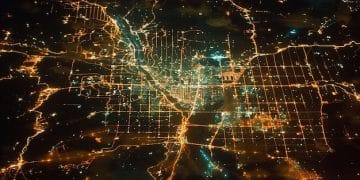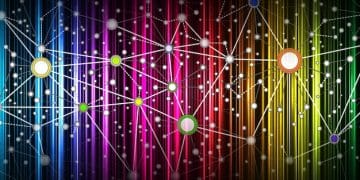Smart Cities in the US: IoT, 5G and the Future of Urban Living

Smart cities in the US are being revolutionized by IoT and 5G technologies, enhancing urban living through improved infrastructure, connectivity, and data-driven services.
The convergence of the Internet of Things (IoT) and 5G technology is rapidly transforming urban landscapes across the United States. Smart Cities in the US: How IoT and 5G are Shaping Urban Living is no longer a futuristic concept but a present-day reality, impacting everything from traffic management to public safety and energy consumption.
Understanding Smart Cities and Their Core Components
Smart cities leverage technology to enhance the quality of life for their citizens. But what exactly defines a smart city, and what are its essential components?
At its core, a smart city integrates information and communication technology (ICT) to manage and optimize urban operations. This involves collecting and analyzing data to improve services and infrastructure.

Key Elements of a Smart City
Several key technologies and approaches underpin the smart city concept, contributing to its effectiveness and sustainability.
- IoT Devices: Sensors and devices connected to the internet collect data on everything from air quality to parking availability.
- 5G Connectivity: High-speed, low-latency 5G networks provide the backbone for transmitting and processing vast amounts of data.
- Data Analytics: Sophisticated analytics tools turn raw data into actionable insights, enabling better decision-making.
- Cloud Computing: Cloud infrastructure provides the necessary storage and processing power for smart city applications.
The integration of these components allows cities to operate more efficiently, respond quickly to challenges, and create a more sustainable environment for residents.
The Role of IoT in Building Smarter Urban Environments
The Internet of Things (IoT) is instrumental in creating intelligent and responsive urban environments. IoT devices are the eyes and ears of a smart city, gathering crucial data that informs decision-making.
By deploying a network of sensors and connected devices, cities can monitor and manage various aspects of urban life in real-time. This data-driven approach enables proactive solutions to common urban challenges.
Applications of IoT in Smart Cities
IoT technology is being applied in a wide range of areas to improve urban living.
- Smart Traffic Management: IoT sensors can monitor traffic flow and adjust traffic signals to reduce congestion.
- Smart Lighting: Connected streetlights can automatically adjust brightness based on ambient light and occupancy, saving energy.
- Waste Management: Sensors in trash cans can detect fill levels and optimize collection routes, reducing costs and emissions.
- Environmental Monitoring: IoT devices can monitor air and water quality, providing early warnings of pollution events.
These applications demonstrate the potential of IoT to transform urban environments into more efficient, sustainable, and livable spaces.
5G Technology as the Backbone of Smart City Infrastructure
5G technology is not just a faster version of 4G; it’s a transformative technology that provides the speed, capacity, and low latency needed to support advanced smart city applications.
With its ability to handle vast amounts of data and connect a massive number of devices, 5G is the ideal infrastructure for the data-intensive operations of smart cities.
Benefits of 5G for Smart Cities
The enhanced capabilities of 5G unlock new possibilities for urban innovation and efficiency.
- Enhanced Connectivity: 5G provides seamless connectivity for a large number of IoT devices, enabling real-time data collection and analysis.
- Low Latency: Ultra-low latency ensures near-instantaneous communication between devices, crucial for applications like autonomous vehicles and remote healthcare.
- Increased Capacity: 5G networks can handle significantly more data traffic than previous generations, supporting the growing demands of smart city applications.
- Network Slicing: 5G allows for network slicing, enabling cities to allocate dedicated network resources for specific applications, such as public safety or transportation.
In summary, 5G is the enabling technology that makes many advanced smart city applications possible, from autonomous vehicles to real-time data analytics.
Smart City Projects and Initiatives Across the US
Several cities across the United States are leading the way in implementing smart city technologies and initiatives. These projects demonstrate the diverse applications of IoT and 5G in urban environments.
From coast to coast, cities are embracing innovative solutions to address challenges related to transportation, energy, sustainability, and public safety.

Examples of Smart City Projects
Here are a few examples of how US cities are using technology to create smarter urban environments:
- New York City: Implementing smart lighting and waste management systems to improve efficiency and reduce environmental impact.
- San Francisco: Deploying autonomous vehicles and smart traffic management systems to reduce congestion and improve transportation.
- Chicago: Using data analytics to improve public safety and address urban challenges.
- Atlanta: Investing in smart energy grids and sustainable infrastructure to reduce carbon emissions.
These projects highlight the potential of smart city technologies to address diverse urban challenges and improve the quality of life for residents. These initiatives are setting the standard for future urban development.
Challenges and Considerations in Implementing Smart Cities
While the potential of smart cities is immense, there are also challenges and considerations that must be addressed to ensure successful implementation.
From concerns about data privacy to the digital divide, cities must carefully navigate the complexities of integrating technology into urban environments.
Key Challenges for Smart City Development
Here are some of the most significant challenges facing smart city initiatives:
* **Data Privacy:** Ensuring the responsible collection and use of data while protecting the privacy of citizens.
* **Cybersecurity:** Protecting smart city infrastructure from cyber threats and vulnerabilities.
* **Digital Divide:** Bridging the gap between those who have access to technology and those who do not, ensuring equitable access to smart city services.
* **Interoperability:** Ensuring that different systems and technologies can communicate and work together seamlessly.
Dealing with these challenges requires careful planning, robust security measures, and a commitment to inclusivity and equity.
The Future of Smart Cities in the US: Trends and Predictions
The future of smart cities in the US is bright, with continued innovation and advancements in technology driving further improvements in urban life.
As IoT and 5G technologies continue to evolve, we can expect to see even more sophisticated and integrated smart city solutions emerge.
Emerging Trends in Smart City Development
Several key trends are shaping the future of smart cities:
* **AI and Machine Learning:** Using AI and machine learning to analyze data and automate processes.
* **Edge Computing:** Processing data closer to the source to reduce latency and improve efficiency.
* **Sustainability:** Prioritizing sustainable solutions and reducing the environmental impact of urban operations.
* **Citizen Engagement:** Involving citizens in the planning and development of smart city initiatives.
These trends suggest that the future of smart cities will be characterized by increased automation, intelligence, and citizen participation.
| Key Point | Brief Description |
|---|---|
| 💡 IoT Integration | IoT devices enhance real-time data collection for informed decisions. |
| 🚀 5G Connectivity | 5G provides high-speed, low-latency connections for smart applications. |
| 🏙️ US Initiatives | Several US cities are pioneering smart city technologies. |
| 🛡️ Addressing Challenges | Handling data privacy and cybersecurity are crucial for smart cities. |
FAQ: Smart Cities in the US
▼
A smart city uses technology to improve the quality of life for its residents. It leverages data to enhance the efficiency of urban services and infrastructure, making cities more sustainable and livable.
▼
IoT deploys sensors and devices to collect real-time data on areas like traffic, waste, and environmental conditions. This data helps cities manage resources more effectively and respond to challenges proactively.
▼
5G provides high-speed, low-latency connectivity essential for supporting a large number of IoT devices. This allows for real-time data processing and enables advanced applications like autonomous vehicles and remote monitoring.
▼
Cities like New York, San Francisco, Chicago, and Atlanta are spearheading smart city projects. They focus on areas such as smart lighting, traffic management, public safety, and sustainable energy solutions.
▼
Key challenges involve safeguarding data privacy, protecting against cybersecurity threats, bridging the digital divide, and ensuring systems are interoperable. Overcoming these issues is crucial for successful, equitable implementation.
Conclusion
The integration of IoT and 5G is revolutionizing urban living in the US, creating smarter, more efficient, and sustainable cities. While challenges remain, the potential benefits are immense, promising a future where technology enhances the quality of life for all citizens.





